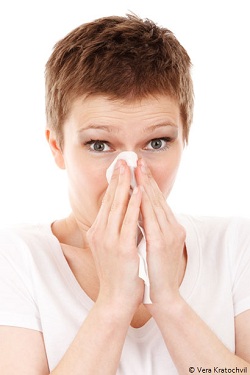The Indoor Allergen Invasion - Coming Soon
How we all hate the cold weather and are grateful for our central heating and double-glazing.
So too is the house dust mite who need the warmth and slightly humid atmosphere that the central heating and double-glazing creates.
Imagine their glee as they snuggle into our carpets, bedding, and soft furnishings and get on with the job of reproducing even more of their kind to give us hapless humans a bad time.
You snuggle into your warm and comfortable bed but do you know you are also snuggling up to two and half million house dust mites and all their droppings.
Almost turns you off going to bed doesn't it!
Even poor old teddy sitting on the end of the bed will be full of the mites.
Everywhere in the house there will be microscopic mould allergens, unable to be seen by the naked eye but for people who react to mould or house dust mite it is the start of what seems like an endless winter cold sometimes triggering asthma and eczema.
Even poor old Rover or Felix is not exempt; the allergens that come from animals doesn't live on their coats as most people think but comes from their saliva and skin flakes they shed.
Even if you restrict them to one part of the house the allergen is sticky so transfers as you walk through, but if you take care you can purify your air.
Don't immediately blame your pet, remember Rover and Felix can also be affected by allergens and have exactly the same symptoms as we do.
So what do we do about this?
How do we get our homes to not be a threat to us?
Simple allergen reduction measures that cost nothing can be taken, creating better environments. OK you won't be popular with the house dust mite, but you may have a winter with less sneezing, wheezing, and itchy skin.
What are allergens?
Allergens are substances that trigger the immune system to promote an allergic reaction.
What is an allergic reaction?
An allergic reaction occurs when the immune system reacts to a normally harmless substance by making a specific antibody to fight it. Each time the person encounters the offending allergen, it links up with the antibody to cause the release of histamine and other chemicals into the tissues. These substances cause the irritation and inflammation of allergic disease.
Allergies occur most commonly in people with a family history of allergic disease, although this is not always the case.
What are the symptoms caused by indoor allergens?
Indoor allergens most commonly affect the nose, chest, skin and eyes:
- Itchy, runny or congested nose, sneezing.
- Irritable airways, coughing, tight chest, wheezing, shortness of breath.
- Itching, watering, inflammation of both eyes.
- Itchy skin, rashes, wheals.
- Congested sinuses and headache.
- Disturbed sleep.
- Poor concentration.
- Symptoms worse indoors, in bed or early morning.
Unlike hay fever, symptoms can occur throughout the year although symptom severity may vary from day to day and is normally worse in winter. You may improve abroad in a hot or very cold but dry place.
What are the main causes of indoor allergies?
House Dust Mites
House dust mites present in all houses in the UK and are the most prevalent of all allergens, causing allergic reactions in 85% of asthmatic children.
The warmth and humidity in modern UK homes is an ideal breeding environment for them. They cannot survive in extremely dry or cold conditions.
Like most living creatures, they require warmth, food and water and, as they cannot drink, they need to absorb moisture through their skin.
Our beds provide the ideal environment, with a supply of our shed skin cells (their food source), water from our sweat, expired breath, and warmth. They also find skin cells and other proteins to eat in carpets, upholstered furniture, fabrics and furry toys.
The allergen which triggers the immune system is mainly in the mite droppings, which are very dry and fragment into fine particles. These become airborne and are easily inhaled deep into our airways and lungs. The particles settle quickly into the depths of our pillows, mattresses, duvets, upholstery and carpets.
Animal Allergens
Animal allergens are the next most frequent cause of allergic reactions. The allergen that triggers allergic responses to animals is 
When the animal grooms, the allergen coats the skin, fur or feathers, and is spread by shed skin cells (dander) as well as by licking. The particle size of the allergen is extremely small and therefore easily airborne and breathed in, causing respiratory symptoms, itchy eyes, sneezing and skin irritation.
Cat allergen, particularly, may be found on walls and ceilings many months, or even years, after the animal has left the house. It can also be found on the clothes and shoe soles of people with a cat, so is easily spread.
Feathers are rarely a cause of allergy although the dust in feather pillows can be a cause of symptoms, as can the mites that grow in them.
Smaller domestic animals, such as guinea pigs and hamsters distribute allergen in the urine in the bedding. This allergen easily becomes airborne when the animal scurries around in its cage.
It is not advisable to keep these pets in the bedrooms of allergic people.
Parrots and other birds are another common cause of allergic reactions to their feathers. Any animals, insect or creature can be a cause of allergic reactions. Even fish are not always the solution, as there are many allergenic proteins in fish food granules, and moulds can flourish in the damp environment.
Mould Spores
Allergy to mould spores is quite common and is often overlooked. Moulds are ubiquitous and present indoors for most of the year. Mould also prefer damp, warmer environments so are particularly found in bathrooms, kitchens, on refrigerator door seals, shower curtains and particularly in houses that have obvious damp patches and black mould on window frames.
Due to the high level of humidity, they are also found in our beds. The water reservoirs of dehumidifiers can be a breeding ground for moulds.
Spores are sometimes hidden underneath wallpaper and commonly present in the soil of houseplants. Houses built in areas of underlying water, and in river valleys, are often damp.
Symptoms from mould allergy may be better in hot, dry weather and become troublesome on damp, cloudy and misty days.
The first thing to do is identify the causal allergen and Allergy UK can help.

www.allergyuk.org
Indoor Allergy Week runs from 14th - 20th November 2011, further information COMING SOON…
